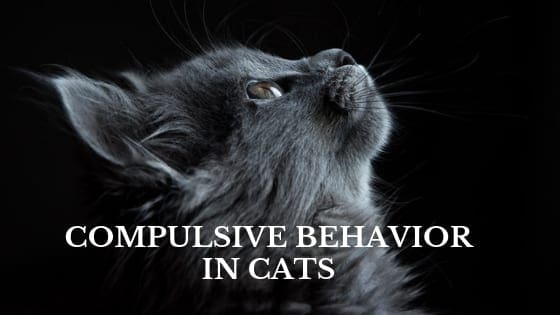
What are compulsive behaviors? There are repetitive behaviors that don’t have a purpose and interfere with the cat’s ability to function normally. In some cases, compulsive behaviors can actually be physically harmful. Compulsive behavior is often the result of ongoing stress or even boredom.
Cats who are exposed to stress on an ongoing basis are most susceptible to developing compulsive behaviors. It may begin as tail chasing or becoming fixated on playing with a laser light. In the case of laser light chasing, some cats then develop a behavior of chasing other flickering lights or reflections. This doesn’t mean that using a laser light with your cat will result in compulsive behavior but it’s something to watch for if you have a cat repeatedly exposed to stress, one who might be beginning to show signs of compulsive behavior, or if you exclusively use the laser light toy during playtime.
Cats and Stress
Cats who are routinely in situations where they are in conflict between running away from a stress trigger or engaging in a confrontation may display compulsive behaviors. If repeatedly put in these conflicted situations, compulsive behaviors may be triggered more quickly and at a lower degree of stress. If untreated, a compulsive behavior can become the cat’s way of dealing with stress and anxiety on a daily basis.
Some signs of compulsive behavior can include:
- Over-grooming
- Hair pulling
- Tail chasing
- Light chasing
- Shadow chasing
- Pacing
- Tail chewing
- sucking on objects
- Licking objects
- Pica (eating non-food items)
Get a Veterinary Diagnosis
If you think your cat is displaying compulsive behavior or any other troubling behavior, contact your veterinarian. Your cat will need to be examined so an accurate diagnosis can be made. Other underlying medical conditions need to be ruled out before labeling the behavior as compulsive.
Some medical conditions that can cause a cat to display a behavior that looks compulsive may include: Injuries to the tail (cats may display tail chewing or chasing), parasites, spinal pain, skin conditions, and allergies, to name just a few. Seizures may also be misdiagnosed as compulsive behavior.
If your veterinarian determines that your kitty is displaying compulsive behavior, anti-anxiety medication might be prescribed to help lower the cat’s stress level. Behavior modification is of the utmost importance when treating a cat with a compulsive behavior disorder. Take a very careful look at your cat’s living situation. The stress levels in the environment must be lowered. If the cat is in a tense multicat environment, make sure there are adequate vertical places for escape such as a cat tree, window perches or other secure locations to help reduce the chances of a physical confrontation. Be sure there are adequate resources for all cats. Does the stressed out cat have to pass through another cat’s area in order to get to the litter box? If so, that’s stressful. Does the stressed out cat always hang back until another cat finished eating? That’s also stressful. Is your home environment chaotic? Have there been changes recently? This is the time to carefully look at the environment from your cat’s point of view.
Alter Your Cat’s Environment
Provide your cat with anxiety-relieving outlets such as engaging in regularly scheduled interactive play sessions. Also, set up activity toys and puzzle feeders and increase the environmental enrichment so kitty has fun things to do while you’re not at home.
Need More Help?
Have your cat checked by the veterinarian for any underlying medical issues. With compulsive behavior issues, your veterinarian may refer you to a behavior professional such as a veterinary behaviorist.
For more information on cat behavior and training, check out the best-selling books by Pam Johnson-Bennett. Pam’s books are available at bookstores and online. We’ve included Amazon links here on our website.
If you have a question regarding your cat’s health, please contact your veterinarian. This article is not intended as a replacement for your cat’s veterinary care. This article is for information purposes only and not offering medical advice or providing a medical diagnosis.




